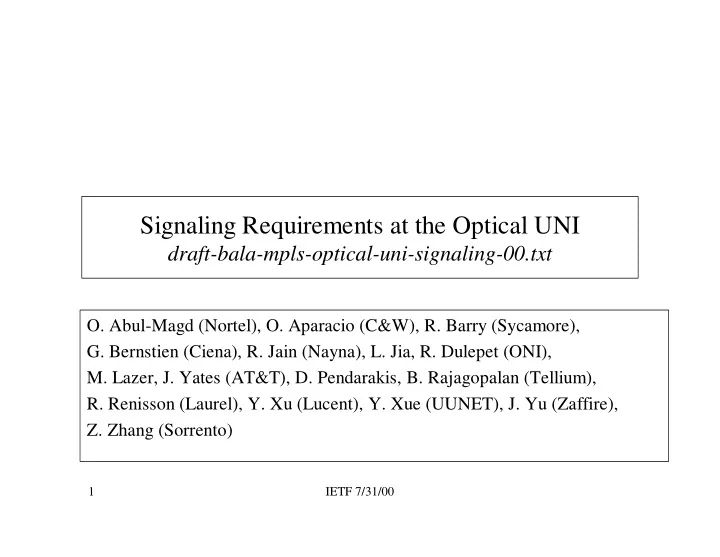

Signaling Requirements at the Optical UNI draft-bala-mpls-optical-uni-signaling-00.txt O. Abul-Magd (Nortel), O. Aparacio (C&W), R. Barry (Sycamore), G. Bernstien (Ciena), R. Jain (Nayna), L. Jia, R. Dulepet (ONI), M. Lazer, J. Yates (AT&T), D. Pendarakis, B. Rajagopalan (Tellium), R. Renisson (Laurel), Y. Xu (Lucent), Y. Xue (UUNET), J. Yu (Zaffire), Z. Zhang (Sorrento) 1 IETF 7/31/00
About this Draft • Describes the domain services model and the optical UNI • Describes the signaling requirements at the UNI • Describes the UNI abstract messages and parameters • Objectives: – Guide the development of an MP?S capability set for UNI signaling (extensions to RSVP/LDP) – Harmonize MP?S mechanisms and attributes with UNI definition/requirements from OIF 2 IETF 7/31/00
The Domain Services Model • Optical network provides well-defined services (e.g., lightpath set-up) • Client-optical interface is defined by actions for service invocation • Client and optical domains operate independently; need not have any routing information exchange across the interface Client Network Client Network Optical Cloud UNI UNI Physical connectivity 3 IETF 7/31/00
Direct and Indirect Signaling Interfaces • Direct Interface: Client equipment and OXC implement UNI signaling over a UNI control channel Optical Network UNI-N UNI-C UNI UNI Internal Connectivity Client Client OXC OXC Client UNI UNI UNI Signaling UNI Signaling Client Client IP Layer IP Layer IPCC 4 IETF 7/31/00
Signaling Interfaces (Contd.) • Indirect Interface: UNI signaling implemented outside of client and/or OXC IPCC Optical Network UNI-C UNI-N UNI ISI Internal Connectivity Client Client OXC ISI: Internal Signaling Client Client Interface 5 IETF 7/31/00
Abstract View of UNI Signaling Optical Network UNI-C UNI-C Internal Functions (Initiating) (Terminating) UNI-N UNI-N (Init.) (Term.) UNI UNI 6 IETF 7/31/00
Optical Network Services • Discrete capacity, high-bandwidth connectivity ( lightpaths ) – Lightpath Creation, Deletion, Modification, Status Enquiry • Directory Services – Determine client devices of interest • Supporting Mechanisms – Neighbor discovery – Service discovery 7 IETF 7/31/00
Signaling Requirements • Automatic or configured determination of UNI control channel endpoints • UNI control channel must be secure, or UNI-C and UNI-N must implement procedures to recognize authorized messages and to prevent unauthorized access • When there are multiple physical links between client and OXC, it is necessary to have only a single control channel. The mapping of the control channel to the link must be automatic, ensuring a functional control channel as long as there is at least one physical link available • Failure of UNI control channel must not result in the removal of lightpaths. • Failure of UNI CC must be detectable in the absence of UNI messaging, and UNI signaling must have a state synchronization mechanism built in. 8 IETF 7/31/00
UNI Abstract Messages Lightpath Create Request - UNI-C ↔ UNI-N • Lightpath Create Response - UNI-N ↔ UNI-C • Lightpath Delete Request - UNI-C ↔ UNI-N • Lightpath Delete Response - UNI-N ↔ UNI-C • Lightpath Modify Request - UNI-C ↔ UNI-N • Lightpath Modify Response - UNI-N ↔ UNI-C • Lightpath Status Enquiry - UNI-C ↔ UNI-N • Lightpath Status Response - UNI-N ↔ UNI-C • Notification - UNI-N → UNI-C • • Concrete realization based on MP?S signaling constructs 9 IETF 7/31/00
Signaling Example UNI-N UNI-N UNI-C UNI-C (Init.) (Term.) (Terminating) (Initiating) Lightpath Create Lightpath Create Request Request 1 2 3 Lightpath Create Optical Lightpath Create Response 4 Response Network 6 5 10 IETF 7/31/00
Parameters • Identification-related • Service-related • Routing-related • Security-related • Administrative • Miscellaneous 11 IETF 7/31/00
Identifiers • Lightpath termination point identifiers – Internal ID: {IP address, port ID, channel ID, sub-channel ID} Client OXC External Interface P1 Identifier Internal T R R Termination T IP 1 P2 Point T R Identifier R T IP 2 IP OXC Client Side Optical Network 12 IETF 7/31/00
Identifiers (Contd.) • User Group ID – 7-octet VPN ID (RFC 2685) • Contract ID – For service provider use (TBD) • Lightpath ID – Assigned by network to uniquely identify lightpath 13 IETF 7/31/00
Service-Related Parameters • Directionality: Unidirectional or bi-directional • Framing: PDH, SONET, SDH, Digital Wrapper, LAN & WAN Ethernet • Bandwidth: Depends on framing. – PDH: DS n , E n – SONET/SDH: STS- n /STM- n – Digital wrapper: TBD – Etc. • Transparency: Depends on framing – For SONET/SDH: PLR-C, STE-C, LTE-C 14 IETF 7/31/00
Service-Related Parameters (Contd.) • Maximum Acceptable Propagation Delay • Service Level – Service-provider interpreted • Priority & preemption : TBD • Protection Mode: Unprotected, 1+1, Shared 15 IETF 7/31/00
Conclusion • Considered the domain services model and described different service invocation methods • Described the UNI signaling requirements, abstract messages and parameters • The objective of the draft is to facilitate the specification of MP?S constructs that can be used to realize the UNI functionality – Functionality may be added incrementally to evolve towards more sophisticated interaction models • The material in the draft reflects ongoing work in OIF. Not all of the concepts described have been approved by OIF. 16 IETF 7/31/00
Recommend
More recommend